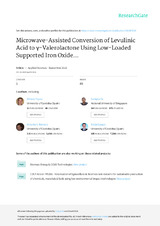Mostrar el registro sencillo del ítem
Microwave-Assisted Conversion of Levulinic Acid to γ-Valerolactone Using Low-Loaded Supported Iron Oxide Nanoparticles on Porous Silicates
| dc.contributor.author | Luque, Rafael | es_ES |
| dc.contributor.author | Romero, Antonio A. | es_ES |
| dc.contributor.author | Climent, María Salud | es_ES |
| dc.contributor.author | De, Sudipta | es_ES |
| dc.contributor.author | Yépez, Alfonso | es_ES |
| dc.date.accessioned | 2017-02-20T11:43:44Z | |
| dc.date.available | 2017-02-20T11:43:44Z | |
| dc.date.issued | 2015 | |
| dc.identifier.uri | http://hdl.handle.net/10396/14534 | |
| dc.description.abstract | The microwave-assisted conversion of levulinic acid (LA) has been studied using low-loaded supported Fe-based catalysts on porous silicates. A very simple, productive, and highly reproducible continuous flow method has been used for the homogeneous deposition of metal oxide nanoparticles on the silicate supports. Formic acid was used as a hydrogen donating agent for the hydrogenation of LA to effectively replace high pressure H2 mostly reported for LA conversion. Moderate LA conversion was achieved in the case of non-noble metal-based iron oxide catalysts, with a significant potential for further improvements to compete with noble metal-based catalysts | es_ES |
| dc.format.mimetype | application/pdf | es_ES |
| dc.language.iso | eng | es_ES |
| dc.publisher | MDPI | es_ES |
| dc.rights | https://creativecommons.org/licenses/by/4.0/ | es_ES |
| dc.source | Applied sciences 5, 532-543 (2015) | es_ES |
| dc.subject | Flow nanocatalysis | es_ES |
| dc.subject | Conversion of levulinic acid | es_ES |
| dc.subject | Hydrogenation | es_ES |
| dc.subject | GVL | es_ES |
| dc.subject | Supported nano particles | es_ES |
| dc.title | Microwave-Assisted Conversion of Levulinic Acid to γ-Valerolactone Using Low-Loaded Supported Iron Oxide Nanoparticles on Porous Silicates | es_ES |
| dc.type | info:eu-repo/semantics/article | es_ES |
| dc.relation.publisherversion | www.mdpi.com/journal/applsci | es_ES |
| dc.relation.projectID | Gobierno de España. CTQ2011 28954-C02-02 | es_ES |
| dc.relation.projectID | Junta de Andalucía. P10-FQM-6711 | es_ES |
| dc.rights.accessRights | info:eu-repo/semantics/openAccess | es_ES |

